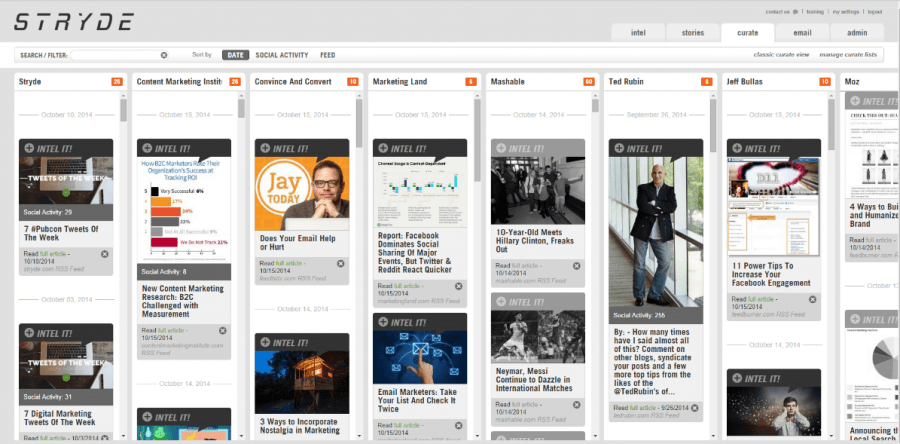Last week I was chatting with an acquaintance about content marketing – social media marketing in particular. He quipped facetiously, “Yeah, getting a bunch of RSS feeds into Hootsuite, or whatever, and pushing a button is so difficult.”
I remained silent. Visibly put off, but silent. There’s so much more to it than that. My acquaintance is a perfect example of an individual who does not understand the importance of content curation and the role it plays in social media marketing.
Content curation is when a team or an individual finds, organizes, offers insights, and shares relevant and premium content hand-picked for the target market.
Why Curation?
The most obvious benefit of content curation is the appeal to your target market. Sharing premium content that isn’t your own builds trust in your brand, and shows your brand’s commitment to its industry.
However, that’s not all. Content curation packs a punch of other serious advantages:
Consistency – When it comes to social media, consistency is key. And unless you’re a publisher, creating that much content is a poor use of your time. Curation fills the gap between times when you share your own content.
Industry News and Insights – Curating content gives you the perfect opportunity to stay current with everything going on in your industry.
Connect with Industry Leaders – Sharing other’s content and tagging them in the post (usually by using @ mentions on Twitter) is a great way to start a conversation and connect with others in your industry that are producing premium content.
Competitive Monitoring – Not only does curation benefit your target market and your own industry insights, but it also allows you to keep a close watch on your competition. Monitoring what types of content they’re creating and sharing gives you great insights into their strategy. Keeping track of what type of their content performs particularly well also serves as a benefit to you.
Content Marketing Mix
 According to Curata, “enlightened” marketers use a content marketing mix that includes 25% curated content.
According to Curata, “enlightened” marketers use a content marketing mix that includes 25% curated content.
That means that if you’re not curating content, you’re only doing 75% of what other marketers are doing.
Even if you are curating content, how can you be sure that you’re doing it right? Think back to my acquaintance, who likened curating to blindly pushing numerous RSS feeds through your social channels. That is a sure-fire way to lose a lot of followers and it certainly is not the right way to do content curation.
Content Curation Is An Art
Content curation is an art: it requires a keen eye, thoughtful additions (and subtractions), and time. When tackling content curation, you must understand that the cost is heavily time-based.
It is not a quick process to sift through hundreds of content pieces from dozens of content sources. Not only that, but you must do that sifting nearly every day.
I’ve experimented with tools that allow you to schedule hundreds of social media posts from dozens of sources. While that is efficient, I found myself reading less and less of the content itself. When I sacrificed a keen eye and thoughtful additions and subtractions for more time, I found that it did a disservice not only to our brand but also to our followers.
That discovery led me to think of the principles of content curation. Interestingly, the principles of design describe content curation wonderfully:
The 9 Principles Of Content Curation Artistry
- Balance – Is your curated content balanced with your created content?
- Emphasis – Does the curated content reinforce your created content?
- Movement – Does the curated content move the reader further into your feed?
- Pattern – Is your target clearly defined by your curated content?
- Repetition – Are you sharing based on a focused topic and/or keyword?
- Proportion – Does the amount of curation complement you created content?
- Rhythm – Are you sharing consistently?
- Variety – Are you curating different content types from different sources?
- Unity – Does the curated content convey wholeness alongside your created content?
The discovery also lead me to the conclusion that we need a better tool – a tool that allows us to give each piece of curated content the attention and insight it deserves so that we can follow the 9 principles listed above.
Finding The Perfect Curation Tool
Most artists will tell you that in order to create a work of art, you need the right tools. The right paints, brushes, and canvas can change the whole outcome of your piece. This is also true with content curation. With the right tool, you can bring the vision in your head of your content mix to life.
Right Intel
The tool we use to curate content is Right Intel. We use Right Intel to identify content to which we can add our own opinions. This curated content can then be published internally among our team and externally to build thought leadership and credibility.
Right Intel’s Curate functionality is our favorite for keeping up with the best content creators in our industry.
Not only can you pull in RSS feeds, but social media feeds as well; talk about serious social listening.
The curation element comes in with the Intel It! function. We add our thoughts on our favorite content pieces from the Curate tab, and that content is then shared with our internal team.

Curation and adding insights are just the tip of the Right Intel capability iceberg. You can also create Stories, which are really only limited by your imagination. Want to recap quarterly content results? No problem. Maybe you want to report on a particular marketing campaign? Easy as pie.
Exporting this content is also simple with Right Intel’s email function. You can import stories or individual content with an eye-pleasing layout. The offerings that Right Intel provides expand even beyond what we touched on here, and have helped us evolve our own content strategy.
Content Curation And Thought Leadership
The artistry of curating content may take a bit of time to master, but you’ll quickly find out how important and vital content curation is to your brand.
Content curation as an art really boils down to a matter of thought leadership. This term is often thrown around in the digital marketing world, but that does not diminish its importance.
To be a true thought leader, one must have thoughts. Shocking, right? These thoughts must be your own and set you apart from the pack. Proper content curation merges your own opinions with others’ and communicates them during the times when you’re not creating your own content.
Content curation is necessary for individual thought leaders, as well as your firm’s brand. Without it, you’re seriously behind the eight ball when it comes to earning credibility within your industry. How do you streamline content curation?





